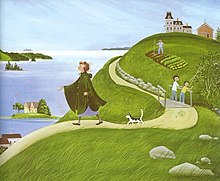Miss Rumphius
Miss Rumphius is a children's picture book written and illustrated by Barbara Cooney and originally published by the Viking Press in 1982.
It features the life story of fictional Miss Alice Rumphius, a woman who sought a way to make the world more beautiful and found it in planting lupines in the wild.
[11] The book[12] opens with the narrator telling readers about a little old woman nicknamed "The Lupine Lady" who "lives in a small house overlooking the sea."
While traveling in the "Land of the Lotus-Eaters" (Tunisia in North Africa), however, she hurts her back getting off a camel and decides that it's time to find her place by the sea.
As she rests and tries to recover, she reflects on how much she loves the lupines outside her bedroom window, and, after discovering a patch of them farther along the cliffs near her home, she realizes how she can accomplish her third and final goal.
She sends off for as many lupine seeds as she can acquire and begins scattering them all over her community—along cliffside roads, near buildings in town, along stone walls, and in hollows between hills.
People who see her think she's crazy, but the following spring, it becomes clear she accomplished her goal; her community is bursting with colorful lupines growing everywhere and she has made the world more beautiful.
Additional themes of female independence, singleness, the impact travel can have in teaching about cultural diversity, and the transformative power of beauty as it is portrayed in Miss Rumphius have all been discussed in numerous articles and blogs.
[13][3][14][15][16][17][18][5][19][20] Though not expressly a work of feminist literature, the main character of Miss Rumphius is viewed by many as a brave woman whose independent lifestyle was ahead of her time.
[22][23] For the historical eras in which the story is set—roughly the 1880s or 1890s when she is a young girl to about the 1960s or 1970s when she is an old woman—marriage was a common expectation of most women at the time, but the Miss Rumphius in the book never marries.
Where some may refer to Miss Rumphius as a spinster, Cooney does not comment on her marital status and instead depicts her life of singleness as brave and beautiful in its own right.


